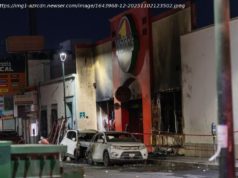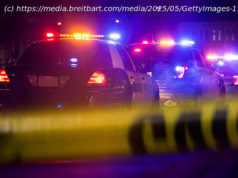The new plan takes effect immediately and fully rolls back an Obama administration executive order.
WASHINGTON — The Trump administration Monday lifted a controversial ban on the transfer of some surplus military equipment to police departments whose battlefield-style response to rioting in a St. Louis suburb three years ago prompted a halt to the program.
The new plan takes effect immediately and fully rolls back an Obama administration executive order that blocked armored vehicles, large-caliber weapons, ammunition and other heavy equipment from being repurposed from foreign battlefields to America’s streets.
Attorney General Jeff Sessions, who led the campaign for the program’s reinstatement, outlined President Trump’s new executive order Monday in an address at the annual meeting of the Fraternal Order of Police, the nation’s largest police union.
The administration’s action, first disclosed by USA TODAY, would restore «the full scope of a longstanding program for recycling surplus, lifesaving gear from the Department of Defense, along with restoring the full scope of grants used to purchase this type of equipment from other sources, » according to a administration summary of the new program recently circulated to some law enforcement groups.
«Assets that would otherwise be scrapped can be re-purposed to help state, local and tribal law enforcement better protect public safety and reduce crime.»
Background: Obama panel cites Camden in police reform report
Obama bans some military equipment sales to police
Many local police already got banned military gear
The FOP and some other law enforcement groups have long been pressing for a reversal of the Obama administration policy, arguing that access to such equipment was needed, especially in cash-strapped communities, to better respond to local unrest.
Civil rights advocates, however, warned that the program’s reinstatement threatened to inflame tensions in minority communities where such equipment has been deployed in the past.
«It is both exceptionally dangerous and irresponsible for the administration to lift the ban on the transfer of certain surplus military equipment to state and local law enforcement organizations, » said Janai Nelson, associate director of the NAACP Legal Defense Fund. «Just a few summers ago, our nation watched as Ferguson raised the specter of increased police militarization. The law enforcement response there and in too many places across the country demonstrated how perilous, especially for black and brown communities, a militarized police force can be.»
Nelson said the timing of the president’s decision, against the backdrop of unrest in Charlottesville, Va., «reflects this administrations now open effort to escalate racial tensions in our country.»
Local access to the high-powered gear was put on national display in 2014 in Ferguson, Mo., where armored vehicles and heavily-armed police clashed with protesters for days following the police shooting of an unarmed 18-year-old black man by a white officer.
The deployment of such equipment, President Obama argued at the time, cast the police as an «occupying force, » deepening a divide between law enforcement and a wary community.
«We’ve seen how militarized gear can sometimes give people a feeling like they’re an occupying force, as opposed to a force that’s part of the community that’s protecting them and serving them, » Obama said in announcing the ban in 2015.
The military gear ban was among a host of policing reform recommendations to flow from a White House advisory group formed in the aftermath of the Ferguson rioting.
The Task Force on 21st Century Policing, chaired by former Philadelphia Police Commissioner Charles Ramsey and Laurie Robinson, a former assistant attorney general, called on law enforcement officials to «minimize the appearance of a military operation» when policing mass demonstrations.
«Avoid using provocative tactics and equipment that undermine civilian trust, » the task force urged.
The previously banned equipment also included tracked armored vehicles, bayonets and grenade launchers.
The Obama order did allow for the limited use of other surplus — aircraft, wheeled tactical vehicles, mobile command units, battering rams and riot gear — on the condition that such equipment was approved by the federal government.
The surplus sharing agreement, also known as the «1033 program, » was created by Congress nearly 30 years ago as part of the National Defense Authorization Act. It was originally intended to assist local law enforcement in drug investigations.
The program was expanded in 1997 to include all local law enforcement operations, including counter-terrorism. Since then, according to the government, more than $5 billion in gear has been transferred to state, local and tribal law enforcement agencies.
«Much of the equipment provided through the 1033 program is entirely defensive in nature … that protect officers in active shooter scenarios and other dangerous situations, » the Trump administration proposal says.






